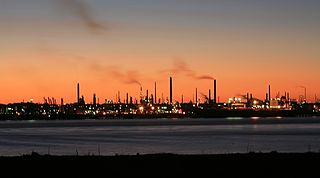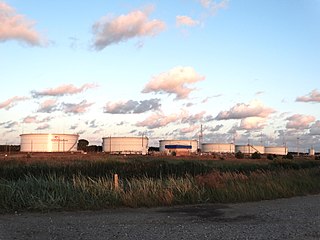
OMV is an Austrian multinational integrated oil, gas and petrochemical company which is headquartered in Vienna, Austria. The company is listed on the Vienna Stock Exchange. In the 2021 Forbes Global 2000, OMV Group was ranked as the 413th -largest public company in the world.
The Odesa–Brody pipeline is a crude oil pipeline between the Ukrainian cities Odesa at the Black Sea, and Brody near the Ukrainian-Polish border. There are plans to expand the pipeline to Płock, and furthermore to Gdańsk in Poland. The pipeline is operated by UkrTransNafta, Ukraine's state-owned oil pipeline company.

The Druzhba pipeline ; also has been referred to as the Friendship Pipeline and the Comecon Pipeline) is one of the world's longest oil pipelines and one of the largest oil pipeline networks in the world. It began operation in 1964 and remains in operation today. It carries oil some 4,000 kilometres (2,500 mi) from the eastern part of European Russia to points in Ukraine, Belarus, Poland, Hungary, Slovakia, the Czech Republic, Austria and Germany. The network also branches out into numerous smaller pipelines to deliver its product throughout Eastern Europe and beyond.

MOL Plc., also known as MOL Group, is a Hungarian multinational oil and gas company headquartered in Budapest, Hungary. Members of MOL Group include among others the Croatian and Slovak formerly state-owned oil and gas companies, INA and Slovnaft. MOL is Hungary's most profitable enterprise, with net profits of $770 million in 2019. The company is also the third most valuable company in Central and Eastern Europe and placed 402 on the Fortune Global 500 list of the world's largest companies in 2013.

Orlen Lietuva is a subsidiary of the Polish PKN Orlen and it owns the Mažeikiai oil refinery as well as the oil-processing plant in Lithuania, the only oil refinery in the Baltic States.

The Caspian Pipeline Consortium (CPC) is a consortium and an oil pipeline to transport Caspian oil from Tengiz field to the Novorossiysk-2 Marine Terminal, an export terminal at the Russian Black Sea port of Novorossiysk. It is one of the world's largest pipelines and a major export route for oil from the Kashagan and Karachaganak fields. The CPC pipeline transfers about 1% of global oil supply and handles almost all of Kazakhstan's oil exports. In 2021, the pipeline exported up to 1.3 million barrels per day (bpd) of Kazakhstan's main crude grade, light sour CPC Blend, which represented 80% of Kazakhstan's total oil production of 1.6 million bpd.

The Baltic Pipeline System (BPS) is a Russian oil transport system operated by the oil pipeline company Transneft. The BPS transports oil from the Timan-Pechora region, West Siberia and Urals-Volga regions to Primorsk oil terminal at the eastern part of the Gulf of Finland.

QatarEnergy, formerly Qatar Petroleum (QP), is a state owned petroleum company of Qatar. The company operates all oil and gas activities in Qatar, including exploration, production, refining, transport, and storage. The President & CEO is Saad Sherida al-Kaabi, Minister of State for Energy Affairs. The company's operations are directly linked with state planning agencies, regulatory authorities, and policy making bodies. Together, revenues from oil and natural gas amount to 60% of the country's GDP. As of 2018 it was the third largest oil company in the world by oil and gas reserves. In 2022, the company had total revenues of US$52bn, a net income of US42.4bn, and total assets of US$162bn. In 2021, QatarEnergy was the fifth largest gas company in the world.
The National Oil Corporation is the national oil company of Libya. It dominates Libya's oil industry, along with a number of smaller subsidiaries, which combined account for around 70% the country's oil output. Of NOC's subsidiaries, the largest oil producer is the Waha Oil Company (WOC), followed by the Arabian Gulf Oil Company (Agoco), Zueitina Oil Company (ZOC), and Sirte Oil Company (SOC).

Fawley Refinery is an oil refinery located at Fawley, Hampshire, England. The refinery is owned by Esso Petroleum Company Limited, a subsidiary of Exxon Mobil Corporation, which acquired the site in 1925. Situated on Southampton Water, it was rebuilt and extended in 1951 and is now the largest oil refinery in the United Kingdom, and one of the most complex refineries in Europe. With a capacity of 270,000 barrels (43,000 m3) per day, Fawley provides 20 per cent of the UK's refinery capacity. Over 2,500 people are employed at the site.
The Ingolstadt–Kralupy–Litvínov pipeline also known as IKL pipeline and MERO pipeline, is a crude oil pipeline in Central Europe. It facilitates the transport of crude oil from Germany to the Czech oil refineries of Kralupy and Litvínov. The name of the Ingolstadt–Kralupy–Litvínov pipeline is misleading, as the pipeline does not start in Ingolstadt and does not run to Kralupy and Litvínov.
The Adria–Wien Pipeline (AWP) is a crude oil pipeline, which connects the Transalpine Pipeline from Würmlach at the Italian-Austrian border with the Schwechat Refinery near Vienna, Austria. It allows oil supplies to Austria from the Italian oil terminal in Trieste.

Adria oil pipeline is a crude oil pipeline in Croatia, Serbia, and Hungary with branch lines to Slovenia and Bosnia and Herzegovina.
Česká rafinérská a.s. was the largest Czech oil refining company and the largest producer of oil products in the country. The company operated two refineries located in Litvínov and Kralupy nad Vltavou with a combined capacity of 175,000 bbl/d (27,800 m3/d). It was shared company of the Unipetrol, ENI and Shell. After the privatization of the Unipetrol, Shell and Conaco sold their portions and subsequently the ENI as well, finally Unipetrol was the sole owner of this company.
The Baltic Pipeline System-2 is a second trunk line of the Baltic Pipeline System. The pipeline is constructed and operated by Russian oil pipeline company Transneft. The BPS-2 was completed in 2011 and began to function in late March 2012.
Transneft Druzhba is a subsidiary of Russia's leading oil transportation and export company Transneft. Transneft Druzhba owns a big network of pipelines within the Russian Federation and neighboring states. It is the main operator of Transneft in management of Druzhba pipeline activities.
Energy in the Czech Republic describes energy and electricity production, consumption and import in the Czech Republic.
The South European Pipeline is a crude oil pipeline system in France, Switzerland, and Germany. It is built and operated by Société du pipeline sud-européen. The system supplies crude oil to refineries in Feyzin, Cressier, Reichstett, and Karlsruhe.
The oil industry in Poland began at Bóbrka Field in 1853, followed by the first refinery in 1854. Poland was the third most productive region in the world in 1900. It now has only a small, mostly state-owned component, with production from its Permian Basin in the west, small and very old fields in the Carpathians in the south, and offshore in the Baltic Sea. For natural gas the country is almost completely dependent on legacy pipelines from the former Soviet Union.

Būtingė oil terminal is an oil terminal near the village of Būtingė in northern Lithuania. Planned, designed and implemented by Fluor Corporation, it is a part of ORLEN Lietuva. Būtingė has been in operation since July 1999, and is the first major petroleum project that Lithuania implemented after it attained independence in 1990. The facilities can accommodate crude oil exports of 8 million tons and imports to the extent of 6 to 8 million tons.










